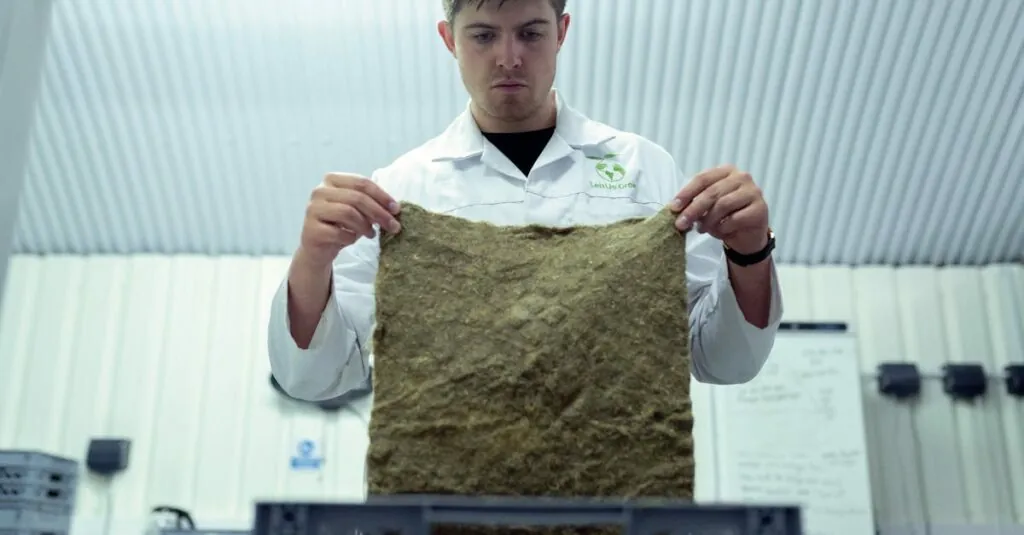In a world drowning in waste, recycled material tech is like a superhero in a spandex suit, ready to save the day. Imagine transforming yesterday’s trash into tomorrow’s treasures. From funky furniture to sleek gadgets, this innovative technology is turning the recycling game on its head.
Table of Contents
ToggleOverview of Recycled Material Tech
Recycled material technology encompasses innovative methods that convert waste into valuable products. This technology revolutionizes various industries by encouraging sustainability and reducing environmental impact. For instance, manufacturers use recycled plastics to create durable outdoor furniture.
In addition, companies utilize recycled metals for construction materials, reducing the need for mining and lowering energy costs. The use of recycled paper significantly lessens deforestation and conserves water, making it vital in the paper industry.
Advanced processes involve sorting, cleaning, and processing discarded items. Manufacturers apply techniques such as pyrolysis to convert plastic waste into fuel and feedstock. Transformative methods emerge from recycling research, leading to higher quality outputs for construction, textiles, and electronics.
Local businesses thrive by adopting these technologies. Entrepreneurs create unique products, attracting environmentally conscious consumers. Economic growth occurs as recycled materials lower production costs.
Innovators push the boundaries of recycled material tech by developing bio-based materials. Alternatives to traditional plastics, like bioplastics, gain traction as they provide similar properties without the environmental drawbacks. This shift toward sustainable material options accelerates consumer demand.
The global market for recycled materials continues to expand, projected to reach approximately $500 billion by 2027. Industry leaders recognize the importance of integrating recycled content into their supply chains. By promoting responsible waste management practices and investing in R&D, businesses ensure a more sustainable future.
Benefits of Recycled Material Tech
Recycled material technology offers significant benefits, particularly in environmental and economic aspects. The adoption of these technologies supports a sustainable future.
Environmental Impact
Recycled material tech dramatically reduces landfill waste. Using recycled plastics and metals conserves natural resources, minimizing the need for new extraction. This process lowers carbon emissions, as recycling typically requires less energy than traditional manufacturing. Additionally, companies that utilize recycled inputs help decrease water usage and fight deforestation. Innovations in recycling also enable the recovery of valuable materials, promoting a circular economy. Implementation of advanced sorting and cleaning processes improves the overall quality of recycled products, elevating their market viability. The cumulative effect of these efforts leads to cleaner ecosystems and promotes biodiversity, making a substantial impact on environmental health.
Economic Advantages
Economic benefits from recycled material tech are notable. Businesses utilizing recycled inputs often experience lower production costs, enhancing profit margins. Consumer demand for sustainable products drives innovation, encouraging local entrepreneurs to create unique, eco-friendly items. This trend stimulates job creation in recycling and manufacturing sectors. The global recycled materials market is projected to reach about $500 billion by 2027, reflecting growing investment in sustainable practices. Companies embracing recycled materials can improve brand reputation, attracting environmentally conscious consumers. As a result, recycled material tech strengthens the economy while promoting environmental stewardship.
Types of Recycled Materials
Recycled materials encompass various categories, each contributing significantly to sustainability and reducing environmental impact. Three main types include plastics, metals, and glass.
Plastics
Recycled plastics play a crucial role in numerous applications. They transform waste into durable products, such as outdoor furniture and packaging. Commonly recycled plastics include PET and HDPE, which have established recycling infrastructures. Innovative methods, like chemical recycling, help improve quality. Producing new items from recycled plastics consumes up to 80% less energy compared to traditional manufacturing. Investments in this sector are expected to grow, responding to heightened consumer demand for sustainable solutions.
Metals
Metals have a high recycling rate, making them a sustainable option for various industries. Aluminum and steel represent key materials that are often recycled. Recycling metals significantly reduces energy consumption; for instance, recycling aluminum uses 95% less energy than producing new aluminum from ore. The process involves melting down scrap metal and reforming it into new products, thereby lowering production costs and emissions. Moreover, the global metal recycling market is projected to reach $300 billion by 2024, reflecting its critical role in the circular economy.
Glass
Glass recycling offers substantial environmental benefits due to its infinite recyclability. It can be crushed, melted, and remolded without losing quality, making it ideal for sustainable packaging. Recycled glass significantly reduces energy usage. Producing new glass containers from recycled glass requires about 30% less energy. Additionally, using recycled glass decreases air pollution, contributing to environmental conservation. Investments in glass recycling technologies continue to rise, emphasizing its importance in sustainable practices across industries.
Innovations in Recycled Material Tech
Recycled material tech continues to evolve, driving sustainable practices across various industries. This ongoing innovation addresses waste management and resource conservation.
Advances in Processing Techniques
Improved processing techniques play a vital role in elevating the quality of recycled materials. Enhanced sorting and cleaning processes ensure higher purity levels, resulting in better end products. Pyrolysis serves as a noteworthy advancement, converting waste into valuable oils and gases for energy applications. Advanced analytics help streamline operations, optimizing efficiency and output. Continuous investment in technology boosts recycling rates and propels the sector forward.
Examples of Successful Applications
Numerous successful applications highlight the versatility of recycled materials. Outdoor furniture crafted from recycled plastics showcases durability while promoting environmental stewardship. Construction materials made from recycled metals, such as aluminum and steel, demonstrate significant energy savings. Unique textiles produced from recycled fabrics appeal to eco-conscious consumers, blending aesthetics with sustainability. These examples illustrate how recycled material tech transforms waste into sought-after products, further solidifying its role in a circular economy.
Challenges Facing Recycled Material Tech
Recycled material technology faces several significant challenges. Contamination in recycling streams often reduces the quality of inputs, which affects the efficacy of processing methods. Sorting materials accurately requires advanced technology, and not all facilities can afford these upgrades. Insufficient consumer awareness leads to lower participation in recycling programs.
Economic factors play a crucial role as well. The market price for recycled materials fluctuates, influencing investment decisions in recycling infrastructure. In many cases, new materials may be cheaper than recycled options, creating a barrier for manufacturers aiming to adopt sustainable practices.
Regulatory hurdles also hinder progress. Inconsistent policies regarding recycling across regions can create confusion for businesses and consumers alike. Adoption of rigorous standards is necessary to ensure consistency and trust in recycled products.
Sustainability efforts sometimes focus on short-term goals rather than long-term investments in recycled material technology. This approach undermines the potential for broader impact by neglecting necessary research and development.
Limited consumer demand impacts the success of recycled products. Many consumers remain unaware of the benefits of items made from recycled materials. Additionally, competition from lower-cost alternatives can discourage manufacturers from prioritizing recycled inputs.
Addressing these challenges requires collaboration among stakeholders, including governments, businesses, and consumers. Increased awareness, investment in technology, and consistent regulations can enhance the effectiveness of recycled material technology and promote a more sustainable future.
Conclusion
Recycled material technology stands at the forefront of sustainable innovation. Its ability to transform waste into valuable products is not just beneficial for the environment but also for the economy. As industries increasingly adopt these practices, the potential for growth and job creation becomes evident.
While challenges remain, such as contamination and market fluctuations, the collective effort of stakeholders can drive significant advancements. By embracing recycled materials, businesses can meet consumer demands for sustainability while contributing to a circular economy. The future of recycled material technology looks promising, paving the way for a greener and more responsible world.





